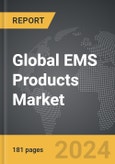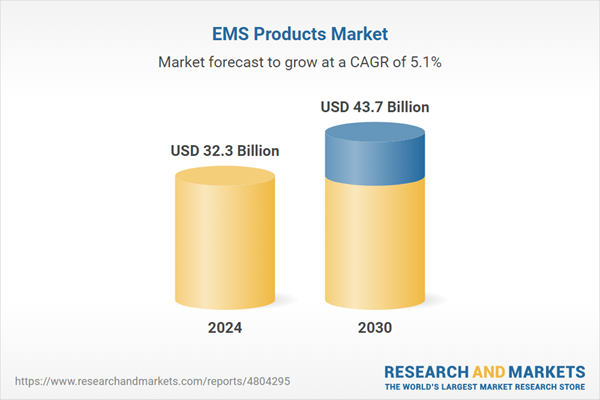Global EMS Products Market - Key Trends and Drivers Summarized
How Are EMS Products Revolutionizing Emergency Medical Services and Patient Care?
EMS products are revolutionizing emergency medical services (EMS) and patient care by providing advanced, reliable, and life-saving tools that enhance the efficiency, effectiveness, and responsiveness of first responders. These products, which range from automated external defibrillators (AEDs) and advanced airway management devices to portable ventilators and trauma care kits, are critical in the fast-paced and high-stakes environment of emergency care. EMS products are designed to be portable, durable, and user-friendly, enabling emergency medical technicians (EMTs) and paramedics to deliver immediate, on-the-scene care that can stabilize patients and significantly improve their chances of survival. The availability of cutting-edge EMS equipment ensures that first responders are equipped to handle a wide range of medical emergencies, from cardiac arrests and severe trauma to respiratory distress and acute allergic reactions. By improving the speed and quality of care delivered in the field, EMS products are vital in bridging the gap between the onset of an emergency and definitive care at a healthcare facility, ultimately saving lives and reducing the long-term impact of medical emergencies.What Innovations Are Enhancing the Functionality of EMS Products?
Innovations in EMS products are enhancing their functionality through advancements in portability, connectivity, and real-time data integration. One of the most significant developments is the miniaturization of medical devices, which has led to the creation of compact, lightweight equipment that is easier to transport and deploy in various emergency situations. For example, portable ultrasound devices and lightweight, high-performance defibrillators are becoming standard in many EMS units, allowing for more comprehensive care on the scene. Another key innovation is the integration of EMS products with digital and wireless technologies, enabling real-time communication between field responders and hospital-based medical teams. This connectivity allows for the transmission of vital signs, ECG readings, and other critical data from the scene of an emergency to the receiving hospital, preparing the medical team for the patient's arrival and improving the coordination of care. Additionally, some EMS products now feature built-in AI and decision-support tools that assist first responders in making quick, accurate clinical decisions in high-pressure situations. For instance, AI-enhanced diagnostic tools can help EMTs assess the severity of injuries or conditions and determine the most appropriate course of action. These innovations are making EMS products more effective, versatile, and responsive to the needs of both patients and first responders, ensuring that emergency care is delivered with greater precision and efficiency.How Do EMS Products Impact Emergency Response and Patient Outcomes?
EMS products have a significant impact on emergency response and patient outcomes by enabling first responders to provide immediate and effective care that can stabilize patients and reduce the severity of injuries or conditions before they reach a hospital. The use of advanced EMS equipment, such as portable ventilators, intravenous (IV) therapy kits, and advanced trauma care tools, allows EMTs to manage critical situations on-site, improving the chances of survival and recovery for patients experiencing life-threatening emergencies. For instance, rapid defibrillation using AEDs can significantly increase survival rates for cardiac arrest patients if administered within the first few minutes. Similarly, advanced airway management tools ensure that patients receive adequate oxygenation, even in challenging conditions. Moreover, the integration of data transmission capabilities in EMS products allows for continuous monitoring and communication with hospital teams, ensuring that the receiving medical facility is fully prepared for the patient's arrival, thereby streamlining the transition of care. The availability and use of modern EMS products also enhance the confidence and capabilities of first responders, enabling them to act swiftly and effectively in a wide range of emergency scenarios. By providing the tools needed to deliver high-quality pre-hospital care, EMS products are crucial in improving patient outcomes and reducing the long-term impact of medical emergencies.What Trends Are Driving Growth in the EMS Products Market?
Several trends are driving growth in the EMS products market, including the increasing prevalence of chronic diseases, the rise of public awareness and preparedness for emergencies, and advancements in medical technology. The growing incidence of chronic conditions such as heart disease, diabetes, and respiratory disorders is leading to a higher demand for emergency medical services, particularly as these conditions often result in acute, life-threatening events that require immediate intervention. This trend is driving the need for more sophisticated and specialized EMS products that can address a broad spectrum of medical emergencies. Additionally, there is a rising awareness of the importance of emergency preparedness, both at the individual and community levels, leading to greater investment in EMS infrastructure and equipment. Governments, healthcare organizations, and even private enterprises are increasingly focused on enhancing their emergency response capabilities, further boosting demand for EMS products. Technological advancements are also playing a critical role in market growth, with innovations such as AI-powered diagnostic tools, portable medical devices, and enhanced communication systems making EMS products more effective and accessible. The integration of EMS products with digital health platforms and telemedicine is expanding their utility, enabling more comprehensive and coordinated emergency care. These trends highlight the expanding role of EMS products in modern healthcare, as they become essential components of both routine emergency response and broader disaster preparedness strategies.Report Scope
The report analyzes the EMS Products market, presented in terms of market value (USD). The analysis covers the key segments and geographic regions outlined below.- Segments: Type (Life Support & Emergency Resuscitation Systems, Patient Monitoring Systems, Wound Care Consumables, Patient Handling Equipment, Infection Control Supplies, Other Types); Application (Cardiac Care, Trauma Injuries, Respiratory Care, Oncology, Other Applications).
- Geographic Regions/Countries: World; United States; Canada; Japan; China; Europe (France; Germany; Italy; United Kingdom; and Rest of Europe); Asia-Pacific; Rest of World.
Key Insights:
- Market Growth: Understand the significant growth trajectory of the Cardiac Care Application segment, which is expected to reach US$17.6 Billion by 2030 with a CAGR of 5.7%. The Trauma Injuries Application segment is also set to grow at 5.5% CAGR over the analysis period.
- Regional Analysis: Gain insights into the U.S. market, valued at $8.9 Billion in 2024, and China, forecasted to grow at an impressive 4.8% CAGR to reach $6.8 Billion by 2030. Discover growth trends in other key regions, including Japan, Canada, Germany, and the Asia-Pacific.
Why You Should Buy This Report:
- Detailed Market Analysis: Access a thorough analysis of the Global EMS Products Market, covering all major geographic regions and market segments.
- Competitive Insights: Get an overview of the competitive landscape, including the market presence of major players across different geographies.
- Future Trends and Drivers: Understand the key trends and drivers shaping the future of the Global EMS Products Market.
- Actionable Insights: Benefit from actionable insights that can help you identify new revenue opportunities and make strategic business decisions.
Key Questions Answered:
- How is the Global EMS Products Market expected to evolve by 2030?
- What are the main drivers and restraints affecting the market?
- Which market segments will grow the most over the forecast period?
- How will market shares for different regions and segments change by 2030?
- Who are the leading players in the market, and what are their prospects?
Report Features:
- Comprehensive Market Data: Independent analysis of annual sales and market forecasts in US$ Million from 2024 to 2030.
- In-Depth Regional Analysis: Detailed insights into key markets, including the U.S., China, Japan, Canada, Europe, Asia-Pacific, Latin America, Middle East, and Africa.
- Company Profiles: Coverage of players such as 3M Company, Argus Embedded Systems Pvt., Ltd., Asteelflash Group, B. Braun Melsungen AG, Baxter International, Inc. and more.
- Complimentary Updates: Receive free report updates for one year to keep you informed of the latest market developments.
Some of the 16 companies featured in this EMS Products market report include:
- 3M Company
- Argus Embedded Systems Pvt., Ltd.
- Asteelflash Group
- B. Braun Melsungen AG
- Baxter International, Inc.
- Bistos Co., Ltd.
- Boston Scientific Corporation
- Cardinal Health, Inc.
- Deltai Medical Health Articles(Suzhou) Company Limited
- GE Healthcare
This edition integrates the latest global trade and economic shifts into comprehensive market analysis. Key updates include:
- Tariff and Trade Impact: Insights into global tariff negotiations across 180+ countries, with analysis of supply chain turbulence, sourcing disruptions, and geographic realignment. Special focus on 2025 as a pivotal year for trade tensions, including updated perspectives on the Trump-era tariffs.
- Adjusted Forecasts and Analytics: Revised global and regional market forecasts through 2030, incorporating tariff effects, economic uncertainty, and structural changes in globalization. Includes historical analysis from 2015 to 2023.
- Strategic Market Dynamics: Evaluation of revised market prospects, regional outlooks, and key economic indicators such as population and urbanization trends.
- Innovation & Technology Trends: Latest developments in product and process innovation, emerging technologies, and key industry drivers shaping the competitive landscape.
- Competitive Intelligence: Updated global market share estimates for 2025, competitive positioning of major players (Strong/Active/Niche/Trivial), and refined focus on leading global brands and core players.
- Expert Insight & Commentary: Strategic analysis from economists, trade experts, and domain specialists to contextualize market shifts and identify emerging opportunities.
Table of Contents
Companies Mentioned (Partial List)
A selection of companies mentioned in this report includes, but is not limited to:
- 3M Company
- Argus Embedded Systems Pvt., Ltd.
- Asteelflash Group
- B. Braun Melsungen AG
- Baxter International, Inc.
- Bistos Co., Ltd.
- Boston Scientific Corporation
- Cardinal Health, Inc.
- Deltai Medical Health Articles(Suzhou) Company Limited
- GE Healthcare
Table Information
| Report Attribute | Details |
|---|---|
| No. of Pages | 181 |
| Published | December 2025 |
| Forecast Period | 2024 - 2030 |
| Estimated Market Value ( USD | $ 32.3 Billion |
| Forecasted Market Value ( USD | $ 43.7 Billion |
| Compound Annual Growth Rate | 5.1% |
| Regions Covered | Global |









